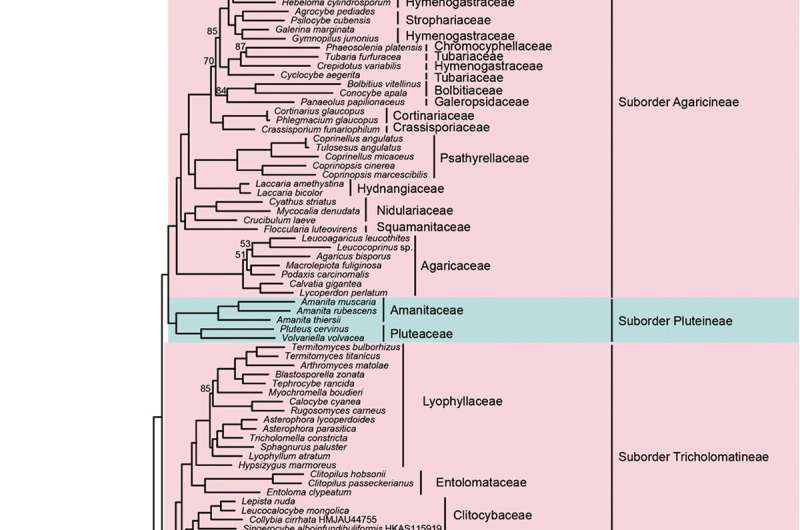This article has been reviewed according to Science X's editorial process and policies. Editors have highlighted the following attributes while ensuring the content's credibility:
fact-checked
proofread
Finding a home for the wandering mushrooms—phylogenetic and taxonomic updates of Agaricales

Many edible, medicinal, and poisonous mushrooms that we are familiar with belong to the order Agaricales, which is a group of fungi with important economic and ecological value. Understanding the phylogenetic relationships of Agaricales can help us to know their evolutionary history and diversity, as well as their interactions with other organisms.
Moreover, the phylogenetic framework of Agaricales can provide a basis for conserving biodiversity, such as measuring phylogenetic diversity and assessing the uniqueness and importance of different species.
Previous studies divided Agaricales into 8 suborders and 46 families, but the systematic position and phylogenetic relationship of some genera and species were unclear. For example, genera Tricholomopsis and Sarcomyxa have been controversial for a long time.
In collaboration with domestic and international colleagues, the research group of fungal diversity and molecular evolution at Kunming Institute of Botany, Chinese Academy of Sciences, conducted genome skimming of fungal specimens from the genera Tricholomopsis, Sarcomyxa, Macrotyphula, Phyllotopsis, and other related groups, and combined them with publicly available genome data of some other species of Agaricales from databases.
Using various analytical methods, such as single-copy orthologous gene extraction, gene conflict detection, phylogenetic tree construction, and topology structure testing, they reconstructed the most resolved and robust phylogenetic framework of Agaricales based on the amino acid sequences of 555 single-copy orthologous genes and clarified the phylogenetic relationships among suborders, as well as the systematic position of Tricholomopsis and Sarcomyxa.
They proposed a new classification system of Agaricales with 10 suborders and adjusted the members of several suborders. They also formally published 2 new suborders (Sarcomyxineae and Phyllotopsidineae), 1 new genus (Conoloma), 2 new sections, and 6 new species, and solved many problems in the classification of Tricholomopsis in China. They also discussed this genus's substrate preference and cap surface scale evolution.
"It has important scientific significance for further understanding the phylogenetic relationships among the major groups of Agaricales," Geng-Shen Wang said.
The study is published in the journal Mycology.
More information: Geng-Shen Wang et al, Phylogenetic and taxonomic updates of Agaricales , with an emphasis on Tricholomopsis, Mycology (2023). DOI: 10.1080/21501203.2023.2263031
Provided by Tsinghua University Press





















